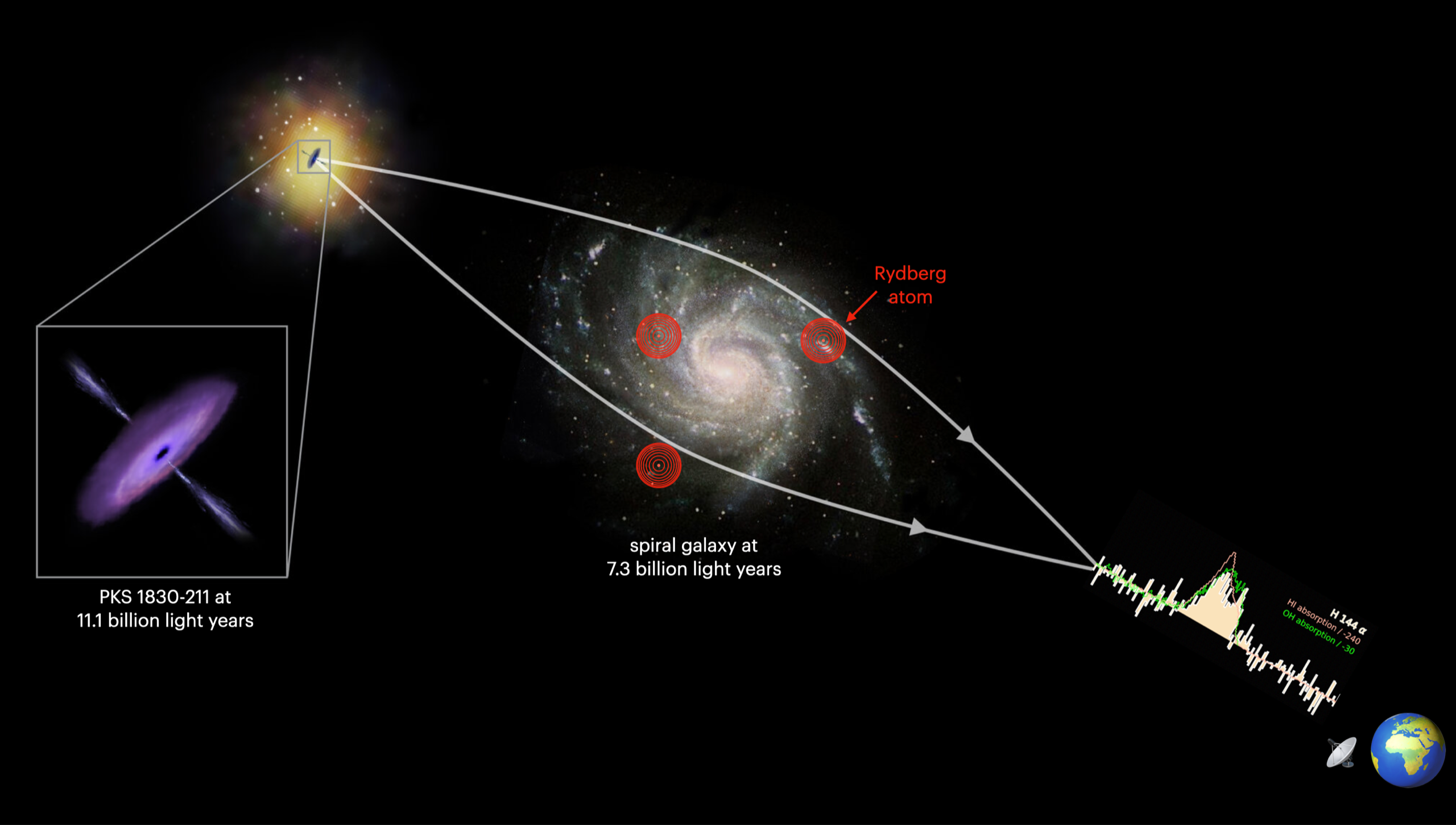
Figure 1: Cartoon depicting gravitational lensing of PKS1830-211 by the foreground galaxy hosting Rydberg atoms.
Image credit: ESA + K. Emig). (https://www.esa.int/ESA_Multimedia/Images/2015/07/Gravitational_lensing)
Image credit: ESA + K. Emig). (https://www.esa.int/ESA_Multimedia/Images/2015/07/Gravitational_lensing)
While using the MeerKAT radio telescope to study a distant galaxy towards PKS 1830-211, scientists discovered something unexpected: gas clouds made up of some of the largest hydrogen atoms in the universe, Rydberg atoms. It is the first time scientists observed these hydrogen atoms in a distant galaxy. What’s more, they believe the large atoms are spread throughout the galaxy in ionized interstellar gas clouds. The discovery could help researchers to understand the nature and evolution of interstellar gas in galaxies and how Rydberg atoms are formed in space. An article reporting this discovery was recently published in the Astrophysical Journal (link).
Located in the constellation Sagittarius, PKS1830-211 is a very distant quasar 11.1 billion light years away (redshift 2.5). However, it is one of the brightest radio sources in the sky. It has a supermassive black hole that gives rise to a high-power jet which is oriented such that it moves in our direction. That makes it appear very bright in the Radio light it emits. PKS 1830-211 is also a hot spot for studying astrochemistry in the universe. The light from PKS 1830-211 happens to pass through a closer by foreground galaxy 7.3 billion light years away (redshift 0.89) on its way to the Earth Astronomers have used this rare alignment to study the molecular chemistry in the spiral arms of the foreground galaxy and discovered the large Hydrogen atoms.
A Rydberg atom refers to any atom with an electron in a high energy state. Radio light couples very well with the Rydberg atoms. Large collections of these atoms, illuminated by Radio light, can become naturally occurring lasers, with them emitting brighter light at the radio wavelengths. Finding just these right conditions for this to occur in distant galaxies has been a long standing quest. For the first time now, next-generation radio telescopes observing the Universe at radio wavelengths from centimeters to meters are making it possible to understand them better.
The South African MeerKAT radio telescope is currently the most sensitive radio telescope observing at these wavelengths. Astronmers are doing large surveys that cover the sky using wide bandwidth receivers which have high enough precision to look for spectral fingerprints from many wavelengths simultaneously. The MeerKAT Absorption Line Survey (MALS; https://mals.iucaa.in/) is one such survey which observes at 18 to 52 cm wavelengths. Because MALS is targeting the brightest radio sources in the sky, it is currently the most sensitive survey for detecting absorption signatures from hydrogen atoms (in the ground state) and molecules like OH – and unexpectedly, also the large Rydberg atoms.
Using the MALS survey led by Neeraj Gupta from IUCAA, an international team of scientists found 44 fingerprints from Rydberg atoms. “We used hydrogen Rydberg atoms to study the physical and dynamic structures in a galaxy 7.3 billion light years away towards PKS 1830-211. The Rydberg atoms could be coming from large clouds of gas that are ionized by high energy light from nearby young massive stars. These atoms tell us that interstellar gas in this galaxy is much more dense than what is found in the Milky Way,” says Kimberly Emig, a Jansky Fellow at the National Radio Astronomy Observatory (NRAO) of USA and lead author of the paper.
Scientists hope to discover more of these oddball atoms. Emig explains, “We were amazed to discover these high-excitation hydrogen atoms in such a distant galaxy. It gives a new way to observe our Universe and possibly study the evolution of interstellar gas in galaxies over cosmic time. They could also help us to understand how interstellar gas drives and inhibits the activity of super massive black holes in galaxies.“
PKS 1830-211 was the first target of observation in MALS. Its observations helped to characterize the performance of the new MeerKAT telescope. The large volumes of MALS data (1.6 petabytes) are processed using an automated pipeline utilizing the task and tools based on the Common Astronomy Software Applications (CASA) package of NRAO, at a dedicated high performance computing facility setup at the Inter-University Centre for Astronomy and Astrophysics (IUCAA), India.
The MALS survey primarily uses a transition of atomic hydrogen at 21 cm wavelengths and transitions from the hydroxyl (OH) molecule at 18 cm wavelengths in order to determine the occurrence of atomic and molecular gas in and around galaxies. “Only a small number of these transitions have been detected in distant galaxies so far due to technical limitations. If we detect a large number (several hundreds) of these transitions, then we can assess the physical conditions of cold gas which serves as fuel for star formation in galaxies. Studying ionized gas through hydrogen Rydberg atoms is highly complementary to studying interstellar gas in its atomic and molecular phases. It would help us to explain the changes in the properties of galaxies at different ages of the Universe,” explains Neeraj Gupta, astronomer at IUCAA and lead investigator of the MALS project.
Making this discovery has been a team effort. The South African Radio Astronomy Observatory operates the MeerKAT telescope. An international collaboration from India, Europe, South Africa, North America, and Australia carries out the MeerKAT Absorption Line Survey. Data from the observations is processed through tools of the National Radio Astronomy Observatory, Inter-University Centre for Astronomy and Astrophysics, and Thoughtworks Technologies India Pvt. Ltd., among others.
Located in the constellation Sagittarius, PKS1830-211 is a very distant quasar 11.1 billion light years away (redshift 2.5). However, it is one of the brightest radio sources in the sky. It has a supermassive black hole that gives rise to a high-power jet which is oriented such that it moves in our direction. That makes it appear very bright in the Radio light it emits. PKS 1830-211 is also a hot spot for studying astrochemistry in the universe. The light from PKS 1830-211 happens to pass through a closer by foreground galaxy 7.3 billion light years away (redshift 0.89) on its way to the Earth Astronomers have used this rare alignment to study the molecular chemistry in the spiral arms of the foreground galaxy and discovered the large Hydrogen atoms.
A Rydberg atom refers to any atom with an electron in a high energy state. Radio light couples very well with the Rydberg atoms. Large collections of these atoms, illuminated by Radio light, can become naturally occurring lasers, with them emitting brighter light at the radio wavelengths. Finding just these right conditions for this to occur in distant galaxies has been a long standing quest. For the first time now, next-generation radio telescopes observing the Universe at radio wavelengths from centimeters to meters are making it possible to understand them better.
The South African MeerKAT radio telescope is currently the most sensitive radio telescope observing at these wavelengths. Astronmers are doing large surveys that cover the sky using wide bandwidth receivers which have high enough precision to look for spectral fingerprints from many wavelengths simultaneously. The MeerKAT Absorption Line Survey (MALS; https://mals.iucaa.in/) is one such survey which observes at 18 to 52 cm wavelengths. Because MALS is targeting the brightest radio sources in the sky, it is currently the most sensitive survey for detecting absorption signatures from hydrogen atoms (in the ground state) and molecules like OH – and unexpectedly, also the large Rydberg atoms.
Using the MALS survey led by Neeraj Gupta from IUCAA, an international team of scientists found 44 fingerprints from Rydberg atoms. “We used hydrogen Rydberg atoms to study the physical and dynamic structures in a galaxy 7.3 billion light years away towards PKS 1830-211. The Rydberg atoms could be coming from large clouds of gas that are ionized by high energy light from nearby young massive stars. These atoms tell us that interstellar gas in this galaxy is much more dense than what is found in the Milky Way,” says Kimberly Emig, a Jansky Fellow at the National Radio Astronomy Observatory (NRAO) of USA and lead author of the paper.
Scientists hope to discover more of these oddball atoms. Emig explains, “We were amazed to discover these high-excitation hydrogen atoms in such a distant galaxy. It gives a new way to observe our Universe and possibly study the evolution of interstellar gas in galaxies over cosmic time. They could also help us to understand how interstellar gas drives and inhibits the activity of super massive black holes in galaxies.“
PKS 1830-211 was the first target of observation in MALS. Its observations helped to characterize the performance of the new MeerKAT telescope. The large volumes of MALS data (1.6 petabytes) are processed using an automated pipeline utilizing the task and tools based on the Common Astronomy Software Applications (CASA) package of NRAO, at a dedicated high performance computing facility setup at the Inter-University Centre for Astronomy and Astrophysics (IUCAA), India.
The MALS survey primarily uses a transition of atomic hydrogen at 21 cm wavelengths and transitions from the hydroxyl (OH) molecule at 18 cm wavelengths in order to determine the occurrence of atomic and molecular gas in and around galaxies. “Only a small number of these transitions have been detected in distant galaxies so far due to technical limitations. If we detect a large number (several hundreds) of these transitions, then we can assess the physical conditions of cold gas which serves as fuel for star formation in galaxies. Studying ionized gas through hydrogen Rydberg atoms is highly complementary to studying interstellar gas in its atomic and molecular phases. It would help us to explain the changes in the properties of galaxies at different ages of the Universe,” explains Neeraj Gupta, astronomer at IUCAA and lead investigator of the MALS project.
Making this discovery has been a team effort. The South African Radio Astronomy Observatory operates the MeerKAT telescope. An international collaboration from India, Europe, South Africa, North America, and Australia carries out the MeerKAT Absorption Line Survey. Data from the observations is processed through tools of the National Radio Astronomy Observatory, Inter-University Centre for Astronomy and Astrophysics, and Thoughtworks Technologies India Pvt. Ltd., among others.
The scientific results of this study are published in:
MeerKAT
The South African MeerKAT radio telescope, situated 90 km outside the small Northern Cape town of Carnarvon, is a precursor to the Square Kilometre Array (SKA) telescope and will be integrated into the mid-frequency component of SKA Phase 1. The MeerKAT telescope is an array of 64 interlinked receptors (a receptor is the complete antenna structure, with the main reflector, sub-reflector and all receivers, digitizers and other electronics installed).MALS
MALS is the MeerKAT Absorption Line Survey. MALS consists of 1655 hrs of MeerKAT time (anticipated raw data ~ 1.7 PB) to carry out the most sensitive search of HI and OH absorption lines at 0<z<2, the redshift range over which most of the cosmic evolution in the star formation rate density takes place. The MALS survey is described in Gupta et al. (2016).Research contacts:
 |
Dr. Kimberly Emig (Jansky Fellow, NRAO, USA) E-mail: kemig_at_nrao.edu |
 |
Prof. Neeraj Gupta (Principal Investigator - MALS, IUCAA, India) E-mail: ngupta_at_iucaa.in |
on the behalf of MALS collaboration.
